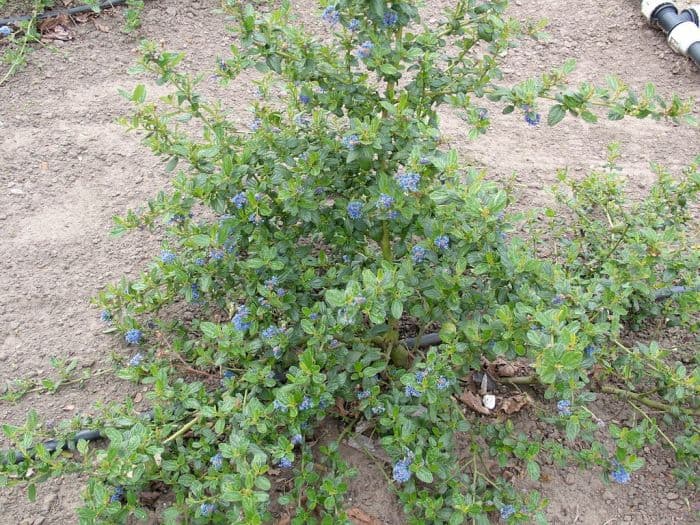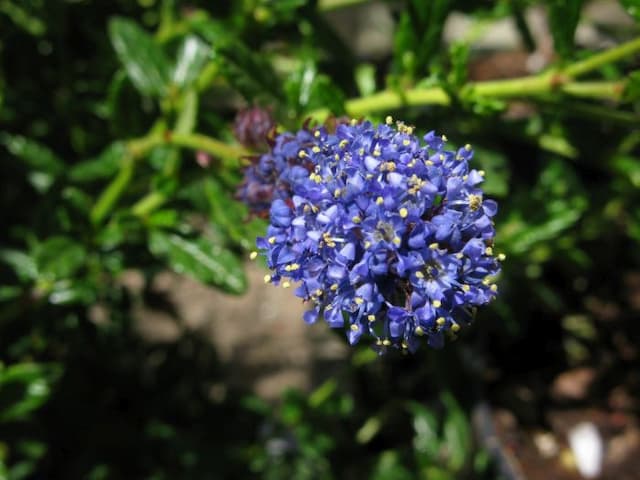Carmel Ceanothus Ceanothus griseus

ABOUT
Ceanothus griseus, commonly known as Carmel Creeper, is a visually striking plant known for its profusion of beautiful blooms and lush foliage. The appearance of this plant is marked by its dense clusters of tiny, vibrant blue flowers that form rounded or arching cone-like shapes. These blossoms stand out against the dark green leaves, which have a small, rounded, and slightly serrated edge, giving the foliage a textured and rich appearance. The leaves themselves have a glossy surface which can catch the light, adding a shimmer to the plant's overall presence in a garden. The contrast between the vivid blue flowers and the glossy green leaves makes Carmel Creeper a favorite among gardeners who desire a plant that offers visual interest and a splash of color. Additionally, it's not uncommon for the plant to attract various pollinators, adding a dynamic element to its appearance when in bloom.
About this plant
 Names
NamesFamily
Rhamnaceae.
Synonyms
Carmel Creeper, Gray-leaf Ceanothus, Carmel Mountain Lilac, Yankee Point.
Common names
Ceanothus griseus horizontalis, Ceanothus thyrsiflorus var. griseus.
 Toxicity
ToxicityTo humans
The plant commonly known as California lilac (Ceanothus griseus) is not known to be toxic to humans. Ingestion of parts of this plant typically does not lead to poisoning or severe adverse effects.
To pets
California lilac (Ceanothus griseus) is also not recognized for being toxic to pets. It's generally considered safe, and there are no common reports of poisoning or significant health consequences if pets ingest parts of this plant.
 Characteristics
CharacteristicsLife cycle
Perennials
Foliage type
Evergreen
Color of leaves
Green
Flower color
Blue
Height
6-9 feet (1.8-2.7 meters)
Spread
6-9 feet (1.8-2.7 meters)
Plant type
Shrub
Hardiness zones
8
Native area
California
Benefits
 General Benefits
General Benefits- Attracts Pollinators: Ceanothus griseus, commonly known as California Lilac, is excellent for attracting bees, butterflies, and other beneficial insects.
- Drought Tolerance: With its adaptability to dry conditions, California Lilac is suitable for xeriscaping and water-wise gardens.
- Erosion Control: The deep root system helps stabilize slopes and hillsides, reducing soil erosion.
- Low Maintenance: Once established, California Lilac requires minimal care, making it ideal for low-maintenance landscapes.
- Decorative Blooms: It produces abundant and showy blue or purple flowers adding aesthetic value to garden spaces.
- Habitat Support: Provides shelter and nesting sites for birds and small animals within its dense foliage.
- Evergreen Foliage: California Lilac offers year-round foliage that keeps gardens looking vibrant even in winter.
- Native Plant Advantages: As a native to California, it supports local ecosystems and adapts well to regional soil and climate conditions.
 Medical Properties
Medical Properties- This plant is not used for medical purposes.
 Air-purifying Qualities
Air-purifying QualitiesThis plant is not specifically known for air purifying qualities.
 Other Uses
Other Uses- Dye Production: Ceanothus griseus, commonly known as California lilac, can be used to produce a natural dye from its leaves and flowers, traditionally used for coloring textiles.
- Low Water Landscaping: This plant is an excellent choice for xeriscaping, a form of landscaping that reduces or eliminates the need for irrigation, thereby conserving water.
- Erosion Control: California lilac's extensive root system helps stabilize slopes and banks, preventing soil erosion in vulnerable areas.
- Hedge Planting: With its dense growth habit, California lilac can be used to create natural, flowering hedges for privacy screens or windbreaks in gardens.
- Beekeeping: The flowers of Ceanothus griseus are a valuable source of nectar and pollen for bees, and the plant can be used to support local beekeeping and pollinator-friendly gardens.
- Eco-Friendly Fertilizer: The plant’s ability to fix nitrogen in the soil makes it a valuable component for improving soil fertility without synthetic fertilizers.
- Wildlife Habitat: It provides shelter and food for various species of birds and insects, enhancing biodiversity within its habitat.
- Live Mulch: Gardeners can use the fallen leaves of California lilac as mulch to suppress weeds and retain soil moisture around other plants.
- Seasonal Interest: This plant is not only useful but also ornamental, offering a vibrant display of blue or purple flowers in the spring and summer that can enhance the aesthetic appeal of any garden setting.
- Fire-resistant Landscaping: California lilac is known for its fire resistance and is often included in firewise landscaping designs to help protect properties in fire-prone areas.
Interesting Facts
 Feng Shui
Feng ShuiThe California Lilac is not used in Feng Shui practice.
 Zodiac Sign Compitability
Zodiac Sign CompitabilityThe California Lilac is not used in astrology practice.
 Plant Symbolism
Plant Symbolism- Resilience: Ceanothus griseus, commonly known as Carmel Ceanothus, often thrives in poor soils and drought conditions, symbolizing the ability to endure and prosper in challenging circumstances.
- Protection: The dense growth habit of Carmel Ceanothus provides shelter for wildlife, representing a haven or protective barrier against external threats.
- Longevity: Carmel Ceanothus is known for its long lifespan among shrubs, signifying enduring life and permanence.
- Beauty: With its attractive dark green foliage and beautiful blue flowers, Carmel Ceanothus is frequently associated with natural beauty and appreciation for the aesthetics of the natural world.
 Water
WaterFor the California Lilac (Ceanothus griseus), it's best to water deeply but infrequently, aiming for about once a week during the growing season if there has been no significant rainfall. Adjust this schedule to account for rainfall and signs that the plant is thirsty, like wilting or dry soil at a depth of a few inches. Mature plants are drought-tolerant and may need less frequent watering. When watering, provide approximately 1-2 gallons of water to the root zone, ensuring that the soil is moistened but not soggy, to encourage deep root growth. During the winter, reduce watering considerably and only water if there has been extended dry weather.
 Light
LightThe California Lilac thrives in full sunlight, so it's best to plant it in a spot where it will receive at least six hours of direct sun daily. However, it can tolerate partial shade, particularly in hotter climates. A location with bright, unfiltered sunlight will promote the healthiest growth and profuse spring flowering.
 Temperature
TemperatureCalifornia Lilac can handle a range of temperatures and is quite hardy in USDA zones 8-10. It can survive minimum temperatures of 10-15 degrees Fahrenheit. The plant prefers a mild climate and does best in temperatures that do not exceed high extremes. Ideal conditions are consistent temperate weather without frequent or rapid fluctuations.
 Pruning
PruningPruning the California Lilac should be undertaken to maintain its shape, remove dead or broken branches, and encourage new growth. It's best to prune right after the plant has finished blooming in late spring or early summer, as pruning too late can remove next year's flower buds. Do not prune more than one third of the plant in a given year to avoid stressing the plant.
 Cleaning
CleaningAs needed
 Soil
SoilFor the Ceanothus griseus, commonly known as Carmel Mountain Lilac, a well-draining soil mix with a pH of 5.5 to 7.5 is ideal. A mix containing 2 parts loam, 1 part sand or perlite, and 1 part well-rotted compost or peat will support healthy growth.
 Repotting
RepottingCarmel Mountain Lilac, or Ceanothus griseus, generally does not require frequent repotting. It can be repotted every 3-4 years or when it has clearly outgrown its current container.
 Humidity & Misting
Humidity & MistingCarmel Mountain Lilac (Ceanothus griseus) thrives in moderate humidity levels, similar to those found in its native Californian coastal habitats, but it is quite adaptable and does not require specific humidity adjustments.
 Suitable locations
Suitable locationsIndoor
Place in bright, indirect light and ensure good air circulation.
Outdoor
Plant in full sun, well-draining soil, and shelter from harsh winds.
Hardiness zone
8-10 USDA.
 Life cycle
Life cycleThe Carmel creeper (Ceanothus griseus) begins its life cycle when its seeds, which require scarification or fire to break dormancy, germinate after being dispersed. Seedlings establish themselves with rapid early growth, developing a deep root system that is well-adapted to arid conditions. The plant then enters a vegetative stage, characterized by the development of distinctive dark green foliage and a dense, bushy habit. As the Carmel creeper matures, it produces clusters of small, blue to violet flowers in the spring, attracting pollinators such as bees and butterflies. After pollination, it sets seed in the form of dry capsules which are distributed by wind or animals. The Carmel creeper can live for many years, with some individuals reaching ages of up to 20-25 years before dying, completing the life cycle.
 Propogation
PropogationPropogation time
Spring to early summer
The most popular method of propagation for the California Lilac (Ceanothus griseus) is through semi-hardwood cuttings. This technique is commonly carried out during the latter part of summer. To propagate, you would select a healthy, non-flowering stem and cut a 4 to 6 inch long (about 10 to 15 cm) section, making the cut just below a node. After stripping the lower leaves, the cut end is often dipped in rooting hormone to encourage root development. The cutting is then inserted into a pot filled with a well-draining soil mix, ensuring at least one node is below the surface. The soil should be kept moist but not waterlogged, and the pot should be placed in a warm area with indirect light until roots have developed and the plant can be transplanted.









